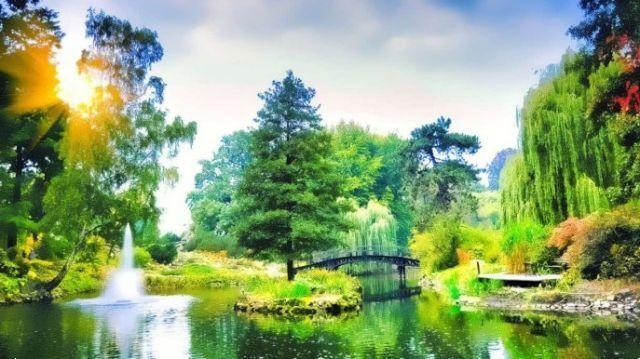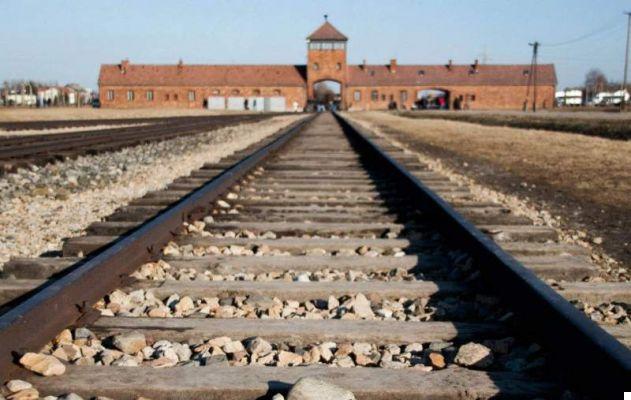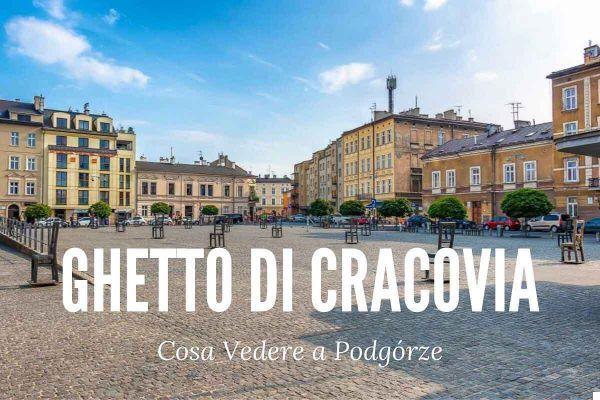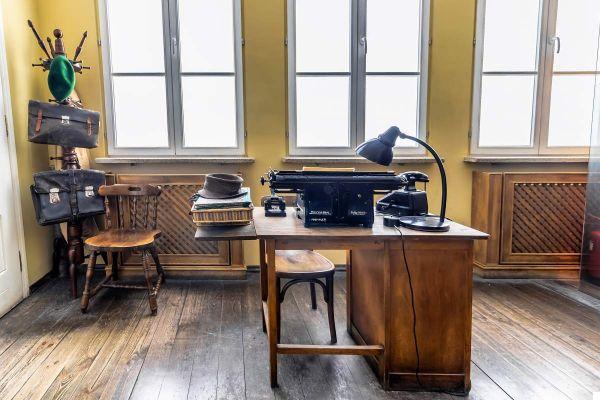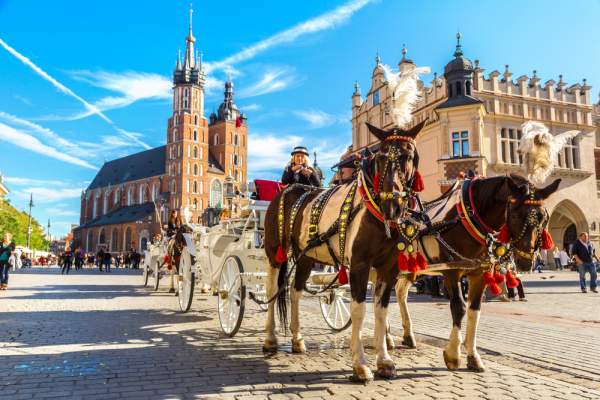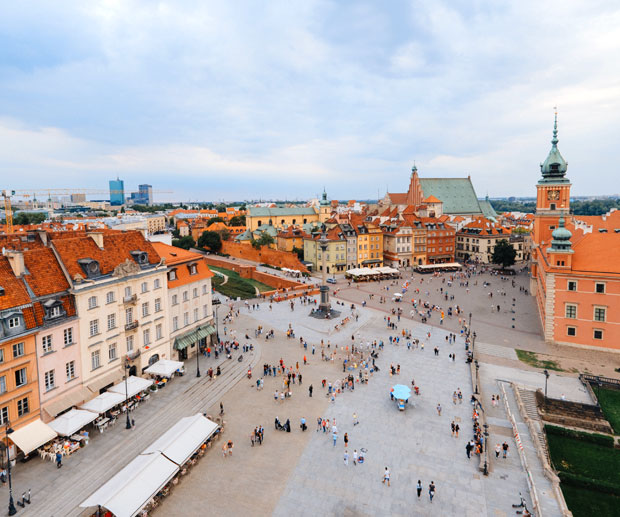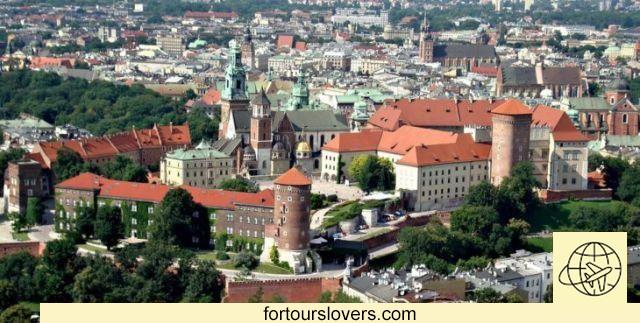
Krakow
13 things to do and see in Krakow and 2 not to doA city that certainly owes to history his tourist primacy nevertheless without ever giving the impression of being an open-air museum. One of Krakow's secrets lies in this ambivalence. The other, so to speak, is the presence of many students. The city, in fact, is a important university center, in Central Europe second for prestige only to the University of Prague. Not surprisingly, despite having lost the status of capital to the advantage of Warsaw, Krakow rightly claims the role of cultural capital of Poland. Cultural but also spiritual, considering the long archbishopric of Karol Wojtyla in the city. As is well known, his twenty years as a bishop in Krakow were decisive for John Paul II: not only for his appointment as pontiff, but also - above all - for the role he played in accelerating the crisis of the Polish communist regime. Apart from these aspects, the tourist success of the city is also explained by the fact that the main points of interest are located in a very small space. In short, Krakow is rich in history, art, culture and more easy to turn. Below, let's see the main tourist attractions together. Happy reading.
1 Rynek Glowny
Rynek Glowny is the obligatory starting point of a holiday in Krakow. We are in heart of Stare Maisto, the old part of the city, that, to be clear, where many of the main tourist attractions are concentrated. It is therefore inevitable to take this stupendous medieval square as the basis of any city tour. Moreover, it itself deserves both from an architectural point of view, surrounded as it is by palaces of the old bourgeoisie and local aristocracy, which from a historical point of view. In the center of the square is the statue of Adam Mickievicz one of the most important figures of XNUMXth century Polish literature. Very nice too Sukiennice, the ancient Palazzo dei Tessuti (see next point) famous, among other things, for hosting the Naworolsky café, the most important in all of Krakow. Fame due to the location, but also to its illustrious acquaintances, starting with Vladimir Lenin, the architect of the October Revolution. Even the Nazi hierarchs, after theGerman invasion of Poland they used to gather at the tables of the Naworolsky cafe. Coffee that was later even expropriated by the communist regime, only to return to its legitimate owners in 1992.
2 Palazzo dei Tessuti
In addition to the Naworolsky café, the arcade of the ancient Cloth Hall in Krakow it's a succession of commercial activities in line with the market vocation of the square and the building itself. Here, in fact, in the past cloths, fabrics and the salt from the nearby were traded Wieliczka mine (about 12 km. from Krakow). For those who do not know, in fact, thesalt mining and its subsequent commercialization have represented for centuries the core business of Krakow, ensuring a considerable economic return of which there is still traces in the architecture of the buildings in the historic center. Today, however, on the first floor of the building there is a picture gallery (Galeria Sztuki Polskiej XIX wieku closed on Mondays) with paintings and sculptures of XNUMXth century Polish art. The picture gallery, together with the Rynek Głowny Underground Museum (see next point) are two very interesting places to visit, especially if the weather is inclement.
3 Underground Museum
Under the Market Square (Rynek Glowny), eight meters deep, a museum has been set up for some years that traces over a thousand years of Krakow's history, from its foundation in the fourth century to the Middle Ages. The archaeological work begun in 2005 should have lasted six months, and instead lasted for over five years, bringing to light a quantity of finds that would allow a sufficiently rigorous historical reconstruction of the medieval past of the city. Krakow, in fact, was playing a leading role under the famous Hanseatic League (Hansa), a complex commercial agreement between German cities, soon extended to cities in other countries of the Baltic Sea and Northern Europe. The visit of Rynek Underground lasts about 60 minutes and also makes use of precious video supports which retrace the many salient moments of the city's history.
For times timetables consult the table
| Opening days | Hours from April to October | Hours from November to March |
| Monday* | 10:00 20:00 |
10:00 20:00 |
| Tuesday** | 10:00 16:00 |
10:00 16:00 |
| Wednesday | 10:00 22:00 |
10:00 20:00 |
| Thursday | 10:00 22:00 |
10:00 20:00 |
| Friday | 10:00 22:00 |
10:00 20:00 |
| Saturday | 10:00 22:00 |
10:00 20:00 |
| Sunday | 10:00 22:00 |
10:00 20:00 |
* Closed every second Monday of the month
** Free
More information: www.podziemiarynku.com (English version available).
4 Town Hall Tower
After having toured the length and breadth of Rynek Glowny, including the underground museum, the appeal cannot miss the Town Hall Tower (Wieża Ratuszowa). Approximately 70 meters high, this tower, once an integral part of the Krakow Town Hall, stands alone on the western side of the square. Upstairs is waiting for you suggestive view of the city, and it is also the main reason why it is worth visiting. The rooms inside, in fact, while offering some interesting insights into local history, do not add anything particularly significant compared to what has already been seen and, above all, to the much more there is to see. In short, the Town Hall Tower (open every day from April to October from 10.30 to 18.00) is a pleasant whim which, moreover, has no particular contraindications. So why not?
5 Collegium Maius
Have you ever heard of the Jagiellone globe? Probably not, yet it is a object of great historical interest. It is the first globe in the world in which theAmerica and dates back to the XNUMXth century. The Jagiellone Globe is just one of the many exhibits present in the Collegium Maius, Jagiellonian University Museum. At the beginning, we recalled the importance of the University of Krakow where, among others, personalities of the caliber of Nicolaus Copernicus e John Paul II. In short, a university of great prestige as can also be seen from the portico from which you enter the University Library. The crystal vault, a frequent architectural solution in the late Gothic period, gives an almost sacred aura to the whole environment, in which the Academic Senate still meets periodically, after centuries. Inside the Collegium Maius, in addition to the collection of ancient scientific instruments (including the Globe mentioned above), all the art and literature collections owned by the university.
For the visiting hours consult the table.
| Opening days | Hours from April to October | Hours from November to March |
| Monday | 10:00 14:20 |
10:00 14:20 |
| Tuesday | 10:00 17:20 |
10:00 14:20 |
| Wednesday | 10:00 14:20 |
10:00 14:20 |
| Thursday | 10:00 17:20 |
10:00 14:20 |
| Friday | 10:00 14:20 |
10:00 14:20 |
| Saturday | 10:00 13:30 |
10:00 13:30 |
| Sunday | Closed | Closed |
More information: www.maius.uj.edu.pl (English version available)
6 Basilica of the Franciscans
Don't be fooled byaustere appearance of the facade. The strong point of the Basilica of the Franciscans (Kosciol Franciszkanow) of Krakow are certainly the interiors. Interior finely decorated by the artist Stanisław Wyspiański to which both the polychrome stained glass windows in the choir and transept that, above all, the stained glass window just after the entrance. The latter represents the "Creation of the World" with the representation of God intent on extracting the Universe from chaos. In cloister of the basilica, however, there is one collection of portraits of the bishops of Krakow, among which stands out, ça va sans dire, the image of Karol Józef Wojtyła which then became, as we know, Pope John Paul II. The Franciscan Basilica is open every day. Admission is free.
7 Basilica of Santa Maria
La St. Mary's Basilica (Kościol Mariacki) it is undoubtedly one of the highlights of a visit to Krakow. The church, dating back to the end of the 200th century, has undergone several renovations over the centuries that have distorted its original layout. Hence the miscellany of styles, from Romanesque to Gothic to Baroque that those with a minimum of artistic sensitivity will not be long in recognizing. The most important work is theAltar built during the fifteenth century byGerman artist Veit Stoss. Stoss also the Christ crucified in the southern nave, while almost all windows were made in the late nineteenth century since that Stanisław Wyspiański of which we spoke earlier about the Basilica of the Franciscans. Do not miss the ascent to the greater of the two towers of the church. 54 meters high, this tower offers a spectacular view of Krakow, but that is not so much why it is famous. In fact, the legend ofHejnał Mariacki rallying call with which the caretaker of the building warned the inhabitants of Krakow about the arrival of hostile forces in the city. However, in 1240, during the invasion of the Tartars, the warning proved fatal. The keeper was in fact pierced by a spear in the middle of the execution of the piece of trumpet. In memory of this episode, every day, at 12 and 19, a trumpet player sings the Hejnał, stopping the performance in the middle in accordance with the requirements of the legend.
For the visiting hours of the Basilica consult the table.
| Opening days | Visiting hours |
| Monday | 11:30 18:00 |
| Tuesday | 11:30 18:00 |
| Wednesday | 11:30 18:00 |
| Thursday* | 11:30 18:00 |
| Friday | 11:30 18:00 |
| Saturday | 11:30 18:00 |
| Sunday and Holidays | 14:00 18.00 |
The Veitt Stoss altar can be visited from 11.50am.
*On the last Thursday of each month, the entrance to the Basilica is until 16:30 pm. In May and October until 17.30 pm.
For the visiting hours of the Basilica Tower consult the table.
| Opening days | Hours from April to October | November, December and March |
| Monday | closed | closed |
| Tuesday | 09:30 17:30 |
closed |
| Wednesday | 09:30 17:30 |
closed |
| Thursday | 09:30 17:30 |
09:10 17:40 |
| Friday | 09:30 17:30 |
09:10 17:40 |
| Saturday | 09:30 17:30 |
09:10 17:40 |
| Sunday | 13:10 17:30 |
closed |
The Tower cannot be visited from 11:30 to 13:10.
January and February closed.
In case of bad weather the Tower will remain closed to tourists.
For more information visit the Official site: mariacki.com (English version available).
8 Planty
The primacy of the largest square in Europe (Rynek Glowny) was not enough, Krakow also boasts that of the largest park. Planty, this is the name of the public garden, it extends for 21 hectares and is about 4 kilometers long. Basically, all of the medieval moat around the old town (Stare Maisto) in the nineteenth century it was first reclaimed and then gradually filled with thousands of plants, benches, ponds and celebratory sculptures historically the most prominent personalities of the city. The presence of such a large green area close to the historic center contributes significantly to the quality of life of the inhabitants of Krakow and, consequently, also to yours tourist fortunes. Here, in fact, after having toured the length and breadth of the city, tourists find an easy refuge for a bit of regenerating relaxation. Not to be missed!
9 Wavel Cathedral
After Stare Maisto, the the Wavel pass and the other a must on a visit to Krakow. On this hill, just over 200 meters above sea level, there are several buildings of great historical and religious interest. The most important are undoubtedly the St. Stanislaus Cathedral and the Royal Palace (see next point). The Cathedral is the most important church in all of Poland. The original building dates back to the year one thousand, but almost no trace remains of that construction. In the 200th, 300th and 400th centuries, the church underwent several renovations which explain the mixture of styles that characterizes the building. In addition to relics of the patron saint, in the church several generations of Polish rulers are buried who here received the coronation at the hands of the bishop. Also here, not without some strasic controversy for the non-entombment of John Paul II (to whom, however, a wing of the Cathedral Museum is dedicated), the President of the Republic Lech Kaczynski, who tragically died in a plane crash in 2010. Among the many things to see deserve a special mention Chapel of Santa Sofia, famous for its Byzantine frescoes and the marble tomb of the Polish king Casimiro Jagellone (by the sculptor Veit Stoss); there Sigismund's Chapel, built in the 500th century by the Florentine architect and sculptor Bartolomeo Berecci; and finally the Chapel of the Waza which instead stands out for its baroque decorations. In short, it is Gothic, Byzantine, Renaissance and Baroque to design the Cathedral of Krakow, of which the Sigismund's Tower. The latter, as well as for the panorama, is famous for the legend of the bell which, they say, gives love and happiness to anyone who touches it.
For times consult the table.
| Days of Operation | April - October | November - March |
| Monday | 09:00 17:00 |
09:00 16:00 |
| Tuesday | 09:00 17:00 |
09:00 16:00 |
| Wednesday | 09:00 17:00 |
09:00 16:00 |
| Thursday | 09:00 17:00 |
09:00 16:00 |
| Friday | 09:00 17:00 |
09:00 16:00 |
| Saturday | 09:00 17:00 |
09:00 16:00 |
| Sunday | 12.30 17:00 |
12.30 15:30 |
More information on Official site: www.katedra-wawelska.pl (English version available).
10 Castle of the Wavel
As we mentioned earlier, together with the Cathedral, the Royal Palace is another must-see in Krakow. In this mansion, for over five centuries, the Polish rulers lived until the decision of King Sigismund III Vasa to transfer the court to Warsaw in 1596. That decision was followed by centuries of decline, which the inhabitants of Krakow never accepted passively. Rather, after the First World War, a popular subscription to raise the necessary funds a transform the structure into a museum. The sum raised far exceeded the required amount, demonstrating the city's attachment to its symbols. Even the museum, however, had a troubled life. During the'German occupation which in fact sanctioned the beginning of the Second World War, the Castle was transformed into general command of the Nazi army and therefore it was necessary to wait for the end of hostilities for the building to return to its cultural vocation. So many things to see: above all the collection of XNUMXth century French silk tapestries, as well as deserves the Treasury of the Crown, whose most important finding is the Szcerbiec sword used during the coronation ceremonies of Polish kings. Finally, it should be remembered that the Lady with an Ermine, a very famous painting by Leonardo Da Vinci housed in the Royal Palace during the renovation of the Czartoryski Museum, was moved to the National Museum of Krakow (after the acquisition by the Polish government of the entire collection of the Czartoryski family).
Il Castello del Wavel is open every day. The times change according to the month (see the table).
| January | 06:00 17:00 |
| February | 06:00 17:00 |
| March | 06:00 18:00 |
| April | 06:00 19:00 |
| May | 06:00 20:00 |
| June | 06:00 21:00 |
| July | 06:00 21:00 |
| August | 06:00 20:00 |
| September | 06:00 19:00 |
| October | 06:00 18:00 |
| November | 06:00 17:00 |
| December | 06:00 17:00 |
More information on Official site: wawel.krakow.pl (English version available).
11 The Remuh Synagogue and the Kazimierz district
La Remuh Synagogue it is the only one of the 7 present in the ancient Kazimierz district where official religious services are still held. Hence the historical importance of this small temple, famous for being named after Iserles Remuh, rabbi of the Jewish community of Krakow revered as a saint by Orthodox Jews around the world. The latter go in procession to his tomb which is located next door Ancient Jewish Cemetery. It is a small cemetery that has been abandoned since the 50th century and which, however, during the German occupation of the city had been contemptuously buried under mounds of earth and debris. In the XNUMXs, a few years after the tragedy of the Holocaust, the cemetery came to light again. Beyond seven hundred tombstones, including that of Rabbi Ramuh, in memory of a community that in the period of maximum splendor exceeded 60.000 units and which today instead has a few hundred members. Nevertheless, the Kazimierz district has for years been experiencing an intense phase of not only spiritual but also commercial and tourist revival. In fact, many commercial and recreational activities have been added to the numerous traces of Jewish culture that have contributed to considerably rejuvenating the image of the neighborhood. The merit, it must be said, is also of the cinema. In Kazimierz, in fact, Steven Spielberg shot in 1993, Schindler's List, film inspired by the story of Oskar Schindler, the German entrepreneur who during the Second World War saved over 1000 Jews from deportation under the pretext of hiring them in his enamel factory. Factory located not far from Kazimierz and which now houses one permanent exhibition on the German occupation of Krakow from 1939 to 1945.
For the times to visit the Schindler's factory (Fabrika Schindlera) check the table.
| Days of Operation | April - October | November - March |
| Monday | 10:00 14:00 |
10:00 14:00 |
| Tuesday | 10:00 18:00 |
09:00 20:00 |
| Wednesday | 10:00 18:00 |
09:00 20:00 |
| Thursday | 10:00 18:00 |
09:00 20:00 |
| Friday | 10:00 18:00 |
09:00 20:00 |
| Saturday | 10:00 18:00 |
09:00 20:00 |
| Sunday | 10:00 18:00 |
09:00 20:00 |
More information on Official site: www.mhk.pl/branches/oskar-schindlers-factory (English version available).
12 Nowa Huta
If you want to deepen the values of Real socialism the visit of Nowa Huta, a suburb of Krakow, is a fundamental experience in many ways. First of all from a historical-political point of view, since Nowa Huta (trans. "New hut“) Was built by the communist government in response to Krakow's excessive intellectualism. In other words, the regime intended to give a signal to the bourgeoisie of Krakow by building a proletarian neighborhood in which steel mill and houses were perfectly integrated. However this claim had to deal with the deep-rooted Catholicism of the workers who soon began to claim a church for their own spiritual needs. L'Ark of the Lord (Arka Pana), the first church of this model socialist city, saw the light at the end of a long back and forth between the workers and the Polish Communist government. Also among the architects of mediation Karol Wojtyla, at the time archbishop of Krakow. It was Wojtyla, in fact, who inaugurated the building in 1977, rewarding the inhabitants of Nowa Huta for years of social struggles that cost victims and bloody repression. So, history, politics, religion but also architecture. In fact, in Nowa Huta, social housing has experienced 2 different seasons. A first, that of the fifties and sixties, in which the ambitions of the regime are evident: the avenues and buildings around the Central Square (Plac Centralny) they betray the Polish Communist government's desire for greatness. The second, on the other hand, referable to the two decades '70 -'80, is emblematic of the progressive decay of the regime: the bill of the condominiums becomes increasingly poor by obeying exclusively the need to guarantee whatever ceiling the growing population. For more information on the church visit the Official site: arkapana.pl.
13 The surroundings of Krakow
La Wieliczka rock salt mine and Auschwitz concentration camp: These are the surroundings of Krakow generally referenced in travel magazines, websites and blogs. Let's talk about two place of great historical interest, both essential stops on a visit to the city. There Wieliczka mineFrom 1978 Unesco World Heritage, is located about 10 kilometers from Krakow, and represents the most precious testimony of the past of this part of Poland to which the marketing of salt has guaranteed well-being and prosperity for centuries. Suffice it to say that the mining activity continued from the 900th century to the beginning of the XNUMXth century. The golden moment, which we mentioned when talking about the Palace of Textiles, was certainly the fourteenth century, when Krakow, strong in its business, played a leading role in Central-Eastern European trade. Then the business slowly began to wane, leaving behind a unique scenario in the world: beyond 300 kilometers of tunnels, inlets, caves and even a salt lake. The main attraction is undoubtedly the Chapel of Santa Kinga where everything, including the candlesticks, is carved in salt. For more information visit the official website: www.kopalnia.pl (Spanish version available). Auschwitz, on the other hand, it is 45 kilometers from Krakow and covers an area of approx 190 hectares where today, instead of the concentration camp, a museum it's a monument. The written on the entrance gate of the camp "Arbeit macht frei" (transl. "Work makes you free") the visit to the site alone is worthwhile, considering that, contrary to what was advocated in this concentration camp, over a million Jews died. The camp can be visited both independently and with the support of a guide. For more information visit the official website: auschwitz.org (English version available).
1 What not to forget in your suitcase
Il Krakow's tourist peak is during the summer, a period in which temperatures can well exceed 30 ° C. Therefore, if you want to visit the city during this period, you must definitely prefer light clothing and sunscreen. But be careful: the climate is more variable than in spain. In other words, sudden downpours and coolness are not remote possibilities, so better act accordingly. All the more so in spring and autumn when, together with windproof and rainproof jackets, you should pack some as well comfortable sweater and shoes. As for thewinter, snow and sub-zero temperatures are almost constant. IS therefore essential is suitable clothing to this type of situation in order not to compromise the outcome of the holiday.
2 Watch out for the zloty (PLN) euro (EUR) exchange rate
Krakow is one international tourist destination and therefore it is not difficult to exchange euros for zlotys. However, the very ease of the operation requires paying a minimum of attention to the rates charged by banks and exchange offices. Usually the ratio between the euro and the zloty is just over 1 to 4 (average value 1 EUR = 4.2 - 4.3 PLN) and this is the value from which it is good not to deviate too much.




